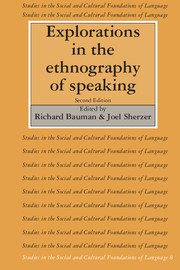Book contents
- Frontmatter
- Contents
- INTRODUCTION TO THE SECOND EDITION
- I PREFACE AND INTRODUCTION
- II COMMUNITIES AND RESOURCES FOR PERFORMANCE
- III COMMUNITY GROUND RULES FOR PERFORMANCE
- IV SPEECH ACTS, EVENTS, AND SITUATIONS
- V THE SHAPING OF ARTISTIC STRUCTURES IN PERFORMANCE
- VI TOWARD AN ETHNOLOGY OF SPEAKING
- Introduction
- 19 Data and Data Use in an Analysis of Communicative Events
- 20 The Ethnography of Writing
- 21 Ways of Speaking
- Notes
- References
- Index of names
21 - Ways of Speaking
Published online by Cambridge University Press: 05 June 2012
- Frontmatter
- Contents
- INTRODUCTION TO THE SECOND EDITION
- I PREFACE AND INTRODUCTION
- II COMMUNITIES AND RESOURCES FOR PERFORMANCE
- III COMMUNITY GROUND RULES FOR PERFORMANCE
- IV SPEECH ACTS, EVENTS, AND SITUATIONS
- V THE SHAPING OF ARTISTIC STRUCTURES IN PERFORMANCE
- VI TOWARD AN ETHNOLOGY OF SPEAKING
- Introduction
- 19 Data and Data Use in an Analysis of Communicative Events
- 20 The Ethnography of Writing
- 21 Ways of Speaking
- Notes
- References
- Index of names
Summary
We start from the speech community conceived as an ‘organization of diversity’; we require concepts and methods that enable us to deal with that diversity, that organization. The great stumbling block is that the kinds of organization most developed by linguists presuppose the grammar as their frame of reference. (By grammar is meant here the genre of grammars.) Since its invention in classical antiquity, the grammar has been dominated by association with analysis of a single, more or less homogeneous, norm. In earlier periods the choice of norm was determined by social constraints. Linguistics, as grammar, came into existence to dissect and teach just that language, or language-variety, that embodied valued cultural tradition (Homeric Greek, the Sanskrit of the Vedas, the Chinese of the Confucian classics), not just any language; indeed, not any other language at all. The grammar, like the language, was an instrument of hegemony. In recent times the choice of norm has been determined often enough by factors intrinsic to the linguistic task. Although the class background of linguists favors the ‘standard’ of the schools, considerations of simplicity, clarity, fullness, of whatever is advantageous to the linguistic task itself, have also entered. Linguists have often been as decisive as schoolmasters in excluding things. With the schoolmaster, exclusion may have been for reasons of prestige and pedantry; with the linguist, it may most often have been for the sake of a model or an elegant result; but the consequence in relation to the speech patterns of a community as a whole has not been too different.
- Type
- Chapter
- Information
- Explorations in the Ethnography of Speaking , pp. 433 - 452Publisher: Cambridge University PressPrint publication year: 1989
- 48
- Cited by



